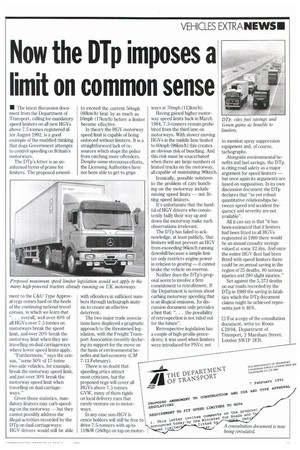Now the Dip imposes a limit on common sense
Page 13

If you've noticed an error in this article please click here to report it so we can fix it.
• The latest discussion document from the Department of Transport, calling for mandatory speed limiters on all new HGVs above 7.5 tonnes registered after August 1992, is a good example of the muddled thinking that dogs Government attempts to control speeding on Britain's motorways.
The Dip's letter is an unashamed hymn of praise for limiters. The proposed amend ment to the C&U Type Approval regs comes hard on the heels of the continuing national travel census, in which we learn that ". . . overall, well over 40% of all HGVs over 7.5 tonnes on motorways break the speed limit, and over 20% break the motorway limit when they are travelling on dual carriageways where lower speed limits apply.
"Furthermore," says the census, "some 50% of 17-tonne two-axle vehicles, for example, break the motorway speed limit, and just over 30% break the motorway speed limit when travelling on dual carriageways."
Given those statistics, mandatory limiters may curb speed ing on the motorway but they cannot possibly address the illegal activities recorded by the DTp on dual carriageways: HG \' drivers would still be able to exceed the current 50mph (80km/h) Limit by as much as lOmph (17km/h) before a limiter became effective.
In theory the HGV motorway speed limit is capable of being enforced without limiters. It is a straightforward lack of resources which stops the police from catching more offenders. Despite some strenuous efforts, the Licensing Authorities have not been able to get to grips with offenders in sufficient numbers through tachograph analysis to create an effective deterrent.
The two major trade associations have displayed a pragmatic approach to the threatened legislation, with the Freight Transport Association recently declaring its support for the move on the basis of environmental benefits and fuel economy (CM 7-13 February).
There is no doubt that speeding artics attract most criticism, but the proposed regs will cover all HGVs above 7.5 tonnes GVW, many of them rigids on local delivery runs that rarely venture on to motorways.
In any case non-HGV licence holders will still be free to drive 7. 5-tormers with up to 119kW (160hp) on tap on motor
ways at 70mph (113km/h).
Having gained higher motorway speed limits back in March 1984, 7.5-tonners remain prohibited from the third lane on motorways. With slower moving HGVs in the middle lane Limited to 60mph (961=111) this creates an obvious risk of bunching. And this risk must be exacerbated when there are large numbers of limited trucks on the motorway, all capable of maintaining 96km/h.
Ironically, possible solutions to the problem of cars bunching on the motorway include raising speed limits — not fitting speed limiters.
Its unfortunate that the handful of HGV drivers who consistently bully their way up and down the motorway make such observations irrelevant.
The DTp has failed to acknowledge, at least publicly, that limiters will not prevent an HGV from exceeding 961unth running downhill because a simple limiter only restricts engine power in relation to gearing — it cannot brake the vehicle on overrun.
Neither does the DTp's proposal seem to involve a firm commitment to retrofitment. If the Department is serious about curbing motorway speeding that is an illogical omission. Its discussion document only provides a hint that: ". . the possibility of retrospection is not ruled out for the future".
Retrospective legislation has a couple of high-profile precedents; it was used when limiters were introduced for PSVs; not to mention spray suppression equipment and, of course, tachographs.
Alongside environmental be
and fuel savings, the DTp is citing road safety as a major argument for speed limiters — but once again its arguments are based on supposition. In its own discussion document the DTp declares that as yet robust quantitative relationships between speed and accident frequency and severity are not available".
All it can say is that "it has been estimated that if limiters had been fitted to all HGVs registered in 1989 there would be an annual casualty savings valued at some £2.6m. And once the entire HGV fleet had been fitted with speed limiters there could be an annual saving in the region of 25 deaths, 80 serious injuries and 290 slight injuries."
Set against the 5,373 deaths on our roads recorded by the DTp in 1989 the saving in fatalities which the DTp document claims might be achieved represents just 0.46%.
















































































